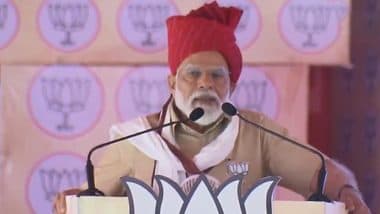New Delhi, May 13: At least 5.14 crore person-years of employment on an average every year has been generated since 2014, according to a report by SKOCH, a think tank which deals in socio-economic issues. The "Employment Generative Impact of ModiNomics: The Paradigm Shifts", is the fifth report in the series of "Outcomes of ModiNomics 2014-24: A Report Card by SKOCH Group" released in New Delhi on Monday.
It studied credit-led interventions and government-led interventions during the period 2014-24. "While credit-led interventions added on average 3.16 crore employment per year, government-led interventions have added 1.98 crore employment," said author of the report Sameer Kochhar, Chairman, SKOCH Group. Pradhan Mantri Mudra Yojana itself has added 2.52 crore employment on an average per year since 2014. Jobs in India: Travel, Tourism Sector Expected To Add 5.82 Crore Jobs Across the Country by 2033, Says NLB Services
The author said the report is important as it studied the employment generative impact of structural credit from formal sources and fractional employment and its treatment. It also tried to break the myth of the inability of small amounts of credit to generate employment. According to Kochhar, "The report provides research-based evidence spread over several years on how credit-led employment and government schemes-led employment have both significantly added to employment since 2014."
Kochhar has authored a series of books on the subject, notable being Financial Inclusion (2009) and Speeding Financial Inclusion (2009). Defeating Poverty: Jan Dhan and Beyond (2014) and India 2047: High Income with Equity (2024) are some of his other works. The current study also finds that micro-loans are being used to generate employment that is steady and stable. "We have documented 80 case studies from our field visits covering borrowers who have taken multiple loans and the average direct employment per loan amount stands at 6.6 jobs," adds Kochhar.
The current study takes into account 12 central schemes, viz., MGNREGS, PMGSY, PMAY-G, PMAY-U, DAY-NULM, RSETI, ABRY, PMEGP, SBM-G, PLI'S, PM SVANidhi. Further, its studies have shown that credit gap has fallen 12.1 per cent during the past nine years. It has also shown a positive correlation between a reduction in credit gap, reduction in multidimensional poverty and an increase in NSDP (Net State Domestic Product). However, it asserted that there is still a lot progress to be made in making credit more accessible in the country, with 211 districts still facing a credit gap of more than 90 per cent. Indian Major IT Companies Laid Off More Than '67,000' Employees in Just One Year: Report
Citing 2005's Rangarajan Committee report, which said 255 districts faced a critical credit outreach gap of 95 per cent, the Skoch report said it has now gone down to 28 districts in 2022. While the average gap is 76.68 per cent in 2022, the average for aspirational districts is 88.33 per cent. "There is a correlation between women's education and access to clean cooking fuel with credit gap."
(The above story is verified and authored by ANI staff, ANI is South Asia's leading multimedia news agency with over 100 bureaus in India, South Asia and across the globe. ANI brings the latest news on Politics and Current Affairs in India & around the World, Sports, Health, Fitness, Entertainment, & News. The views appearing in the above post do not reflect the opinions of LatestLY)













 Quickly
Quickly


